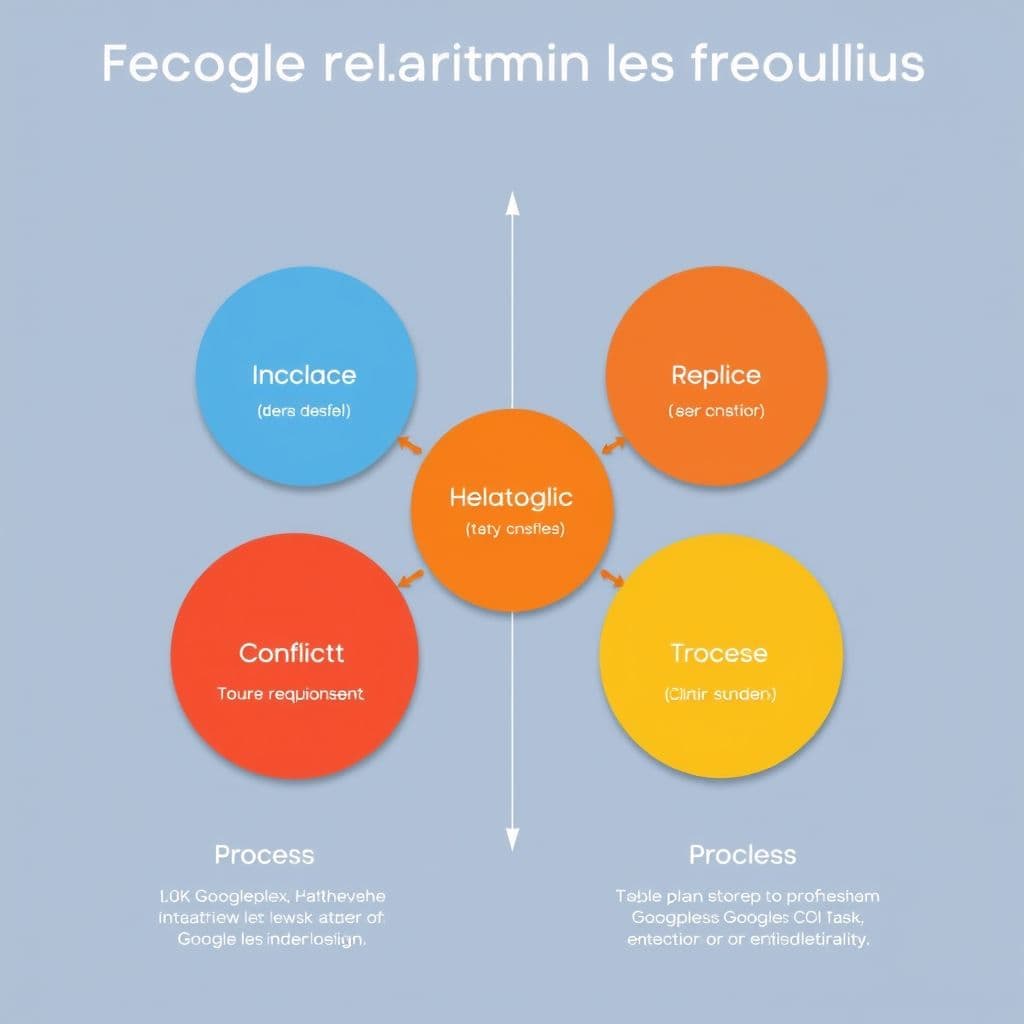Master Conflict Resolution: 8 Essential Steps to Transform Disputes into Opportunities

Conflict is inevitable in human relationships, whether in the workplace, at home, or in our communities. However, what separates successful leaders, collaborators, and relationship builders from the rest is their ability to transform conflicts from destructive forces into opportunities for growth, understanding, and stronger connections. Conflict Resolution Mastery isn't just about putting out fires—it's about developing a comprehensive skill set that enables you to navigate disagreements with confidence, empathy, and strategic thinking. This guide will take you through eight progressive steps that will transform you from someone who avoids conflict into someone who can skillfully guide any dispute toward a constructive resolution. Whether you're a manager dealing with team tensions, a parent navigating family disagreements, or simply someone who wants to improve their interpersonal relationships, these evidence-based techniques will provide you with the tools you need to become a master of conflict resolution. View original learning path
Step 1: Understand the Nature of Conflict
Before you can effectively resolve conflicts, you must first understand what you're dealing with. Conflict isn't simply disagreement—it's a complex dynamic that emerges when two or more parties perceive their interests, needs, or values as incompatible. The definition of conflict encompasses situations where individuals or groups believe that others are preventing them from achieving their goals or satisfying their needs. Understanding the various types of conflict is crucial for applying the right resolution approach. Task conflicts arise over goals, procedures, or work distribution. Relationship conflicts stem from personal tensions and incompatibilities. Process conflicts occur when there's disagreement about how to accomplish tasks. Each type requires different strategies and levels of intervention. The causes of conflict are equally diverse, ranging from miscommunication and competing resources to personality clashes and organizational changes. What makes conflict particularly challenging is that unresolved disputes don't simply disappear—they escalate, creating toxic environments that affect productivity, relationships, and well-being. The effects of unresolved conflict include decreased morale, increased stress, reduced collaboration, and ultimately, the breakdown of relationships and systems. By recognizing these patterns early, you position yourself to intervene before minor disagreements become major crises.

Step 2: Develop Self-Awareness and Emotional Intelligence
The most effective conflict resolvers are those who have mastered themselves first. Self-reflection and self-awareness form the bedrock of conflict resolution skills because you cannot guide others through emotional terrain you haven't learned to navigate yourself. This means regularly examining your own triggers, biases, and emotional patterns. What situations make you defensive? When do you become reactive rather than responsive? Emotional intelligence and empathy are your secret weapons in conflict resolution. Emotional intelligence involves recognizing your own emotions as they arise, understanding their impact on your thinking and behavior, and managing them effectively. Empathy goes beyond sympathy—it's the ability to genuinely understand and share the feelings of others, even when you disagree with their position. Recognizing and managing personal biases is perhaps one of the most challenging aspects of this step. We all have unconscious biases that affect how we interpret situations and people's motivations. Successful conflict resolvers actively work to identify these biases and compensate for them. This might involve questioning your initial assumptions, seeking alternative perspectives, or deliberately considering how your background influences your interpretation of events. Controlling emotions and staying calm under pressure is a skill that can be developed through practice. Techniques such as deep breathing, pausing before responding, and reframing situations can help you maintain the emotional equilibrium necessary for effective conflict resolution.
Step 3: Improve Communication Skills
Communication is the vehicle through which all conflict resolution occurs, making these skills absolutely critical to your success. Active listening goes far beyond simply waiting for your turn to speak. It involves giving your full attention to the speaker, listening for both content and emotions, and demonstrating that you've heard and understood their message. This means maintaining eye contact, using encouraging nonverbal cues, and resisting the urge to formulate your response while the other person is still talking. Effective verbal and non-verbal communication requires alignment between what you say and how you say it. Your tone, posture, and facial expressions often communicate more than your words. Learn to use open body language, maintain a calm tone even when discussing heated topics, and choose words that de-escalate rather than inflame tensions. Asking open-ended questions is an art that can transform conflicts from adversarial battles into collaborative problem-solving sessions. Instead of asking 'Why did you do that?' which puts people on the defensive, try 'What led to that decision?' or 'Help me understand your perspective on this.' These questions invite explanation rather than defensiveness. Paraphrasing and summarizing are powerful tools that demonstrate understanding and help clarify miscommunications. When you reflect back what you've heard, you accomplish several things: you show respect for the speaker's perspective, you verify your understanding, and you give the speaker an opportunity to clarify or correct any misunderstandings.

Step 4: Learn Negotiation Techniques
Negotiation is at the heart of conflict resolution, but effective negotiation goes beyond simply trying to get what you want. Principled negotiation, developed by the Harvard Negotiation Project, focuses on separating people from problems, focusing on interests rather than positions, generating multiple options for mutual gain, and using objective criteria for decision-making. This approach transforms negotiations from win-lose battles into collaborative problem-solving endeavors. Identifying interests and positions is crucial for finding creative solutions. A position is what someone says they want, while an interest is why they want it. For example, two departments might both position themselves as needing the same conference room (position), but their underlying interests might be different—one needs quiet space for client calls while the other needs space for collaborative brainstorming. Once you understand the underlying interests, you can often find solutions that satisfy both parties. Creating win-win solutions requires creativity and a genuine commitment to finding outcomes that benefit all parties. This often involves expanding the pie rather than fighting over how to divide it. Look for ways to add value, find complementary needs, or sequence solutions over time. Sometimes the best solutions are ones that nobody initially considered. Managing concessions and compromises is a delicate balancing act. Not all concessions are equal—some cost you little but provide significant value to the other party. Learn to identify these high-value, low-cost trades and use them strategically. When compromises are necessary, frame them as mutual adjustments toward a shared goal rather than losses.
Step 5: Practice Mediation and Facilitation
Sometimes the most powerful role you can play in conflict resolution is that of a neutral third party. Taking on the neutral third-party role requires stepping back from your own stake in the outcome and focusing entirely on helping others find their own solutions. This neutrality isn't just about being fair—it's about creating space for all parties to be heard and understood without judgment. Creating a safe and respectful environment is fundamental to successful mediation. This involves establishing ground rules for interaction, ensuring equal speaking time, and maintaining confidentiality when appropriate. People need to feel safe to be vulnerable and honest about their concerns and needs. This safety comes from your demeanor, the physical environment, and the boundaries you establish and maintain throughout the process. Facilitating constructive dialogue means guiding conversations toward productive outcomes while allowing the parties to maintain ownership of both the problem and the solution. This requires asking the right questions at the right times, redirecting conversations when they become unproductive, and helping parties reframe their statements in more constructive ways. You become a translator, helping each side understand what the other is really saying. Finding common ground and consensus often requires helping parties discover shared values, goals, or concerns that they might not have initially recognized. Even bitter enemies usually share some common ground—perhaps they both want what's best for their organization, their family, or their community. Once you help them identify these shared interests, you can build solutions around them.
Step 6: Manage and Resolve Conflicts
This is where all your previous learning comes together into practical action. Conflict resolution models and frameworks provide structured approaches to managing disputes. Popular models include the Thomas-Kilmann Conflict Mode Instrument, which identifies five conflict-handling modes (competing, accommodating, avoiding, compromising, and collaborating), and the Interest-Based Problem Solving model, which focuses on identifying underlying needs and interests. Having these frameworks in your toolkit gives you multiple approaches to try when one isn't working. Analyzing and understanding conflict dynamics involves looking beyond the surface disagreement to understand the underlying patterns, power structures, and emotional undercurrents that fuel the conflict. Who are the key stakeholders? What are the formal and informal power dynamics? How has the conflict evolved over time? What attempts at resolution have already been tried? This analysis helps you choose the most appropriate intervention strategy. Generating and evaluating options is a creative process that benefits from diverse perspectives and brainstorming techniques. The goal is to create multiple potential solutions before evaluating any of them. This prevents premature closure on suboptimal solutions and often reveals creative alternatives that satisfy everyone's core needs. When evaluating options, consider not just immediate outcomes but long-term implications, implementation challenges, and potential unintended consequences. Implementing and monitoring solutions requires careful planning and follow-through. Even the best agreements can fail if they aren't properly implemented. This means establishing clear next steps, assigning responsibilities, setting timelines, and creating mechanisms for monitoring progress and addressing challenges that arise during implementation.
Step 7: Develop Cultural Competence
In our increasingly diverse and globalized world, cultural competence is not optional—it's essential for effective conflict resolution. Understanding cultural differences and norms means recognizing that people from different backgrounds may have fundamentally different approaches to conflict, communication, and relationship building. Some cultures value direct confrontation as a sign of respect and honesty, while others see it as rude and potentially relationship-damaging. Some cultures prioritize individual rights and autonomy, while others emphasize collective harmony and consensus. Respecting diversity and inclusivity goes beyond tolerance—it requires actively valuing different perspectives and approaches as potential sources of creative solutions. This means creating space for different communication styles, decision-making processes, and problem-solving approaches. It also means being aware of how power dynamics, historical context, and systemic inequalities might influence how different groups experience and respond to conflict. Adapting communication and conflict resolution approaches based on cultural context demonstrates both respect and effectiveness. This might mean adjusting your communication style, pacing, or even your role in the resolution process. For example, in some cultures, having a respected elder or authority figure present might be essential for any agreement to be legitimate. In others, peer-to-peer problem solving might be more appropriate. Avoiding cultural misunderstandings requires both cultural knowledge and cultural humility—the recognition that you don't know everything about other cultures and the willingness to ask questions, make mistakes, and learn from them.

Step 8: Continuously Learn and Reflect
Mastery in conflict resolution is not a destination but a continuous journey of growth, learning, and refinement. Seeking feedback and self-improvement requires the humility to recognize that every conflict situation offers opportunities to learn and grow. This means actively soliciting feedback from parties involved in conflicts you've helped resolve, from colleagues who observe your conflict resolution efforts, and from mentors or coaches who can provide objective perspectives on your development. Create systems for gathering this feedback regularly and systematically. Reflecting on past conflicts and lessons learned is a practice that transforms experience into wisdom. After each significant conflict resolution effort, take time to analyze what worked well, what could have been improved, and what you learned about yourself and others in the process. Keep a conflict resolution journal where you document key insights, successful strategies, and areas for improvement. This reflection practice helps you identify patterns in your approach and continuously refine your skills. Staying updated on conflict resolution research and practices ensures that your skills remain current and evidence-based. The field of conflict resolution is constantly evolving, with new research on negotiation, mediation, cultural competence, and organizational dynamics regularly emerging. Subscribe to relevant journals, attend conferences or workshops, and engage with professional associations in the field. Adapting strategies based on new insights requires the flexibility to modify your approach as you learn and grow. This might mean abandoning techniques that you discover are less effective than you thought, incorporating new approaches that research has validated, or adjusting your style based on feedback you've received. The best conflict resolvers are those who remain curious, humble, and committed to continuous improvement throughout their careers.
Conclusion
Conflict Resolution Mastery is more than just a professional skill—it's a life skill that enhances every relationship and interaction you have. Through these eight progressive steps, you've learned not just techniques and strategies, but a comprehensive approach to understanding, managing, and transforming conflicts into opportunities for growth and connection. Remember that mastery comes through practice, reflection, and continuous learning. Start applying these concepts in small, low-stakes situations to build your confidence and refine your skills. Pay attention to the conflicts around you—not as problems to avoid, but as opportunities to practice and improve. The world needs more skilled conflict resolvers who can bridge divides, facilitate understanding, and help create more harmonious communities, workplaces, and relationships. Your journey toward Conflict Resolution Mastery begins now, and every conflict you encounter is an opportunity to practice these life-changing skills.
Frequently Asked Questions
- How long does it take to master conflict resolution skills?
- Conflict resolution mastery is a lifelong journey, but you can start seeing improvements in your effectiveness within weeks of consistent practice. Basic competency typically develops over 3-6 months of regular application, while advanced mastery can take several years of experience with diverse conflict situations.
- What are common mistakes beginners make in conflict resolution?
- Common beginner mistakes include taking sides too quickly, focusing on positions rather than interests, avoiding difficult conversations, trying to solve conflicts too quickly without understanding the underlying dynamics, and neglecting to follow up on agreements. The key is to slow down, listen more, and resist the urge to immediately jump to solutions.
- Can conflict resolution skills be applied to personal relationships?
- Absolutely! These skills are equally valuable in personal relationships, family dynamics, and community interactions. In fact, practicing conflict resolution in personal settings often provides excellent training for professional situations, as personal conflicts tend to involve higher emotional stakes and deeper relationship dynamics.
- What if the other party refuses to participate in conflict resolution?
- When others refuse to engage, focus on what you can control: your own responses, communication style, and approach. Sometimes modeling good conflict resolution behavior can encourage others to participate. You can also work on understanding their perspective, addressing their concerns about the process, or finding alternative ways to reach resolution that feel safer or more appealing to them.





